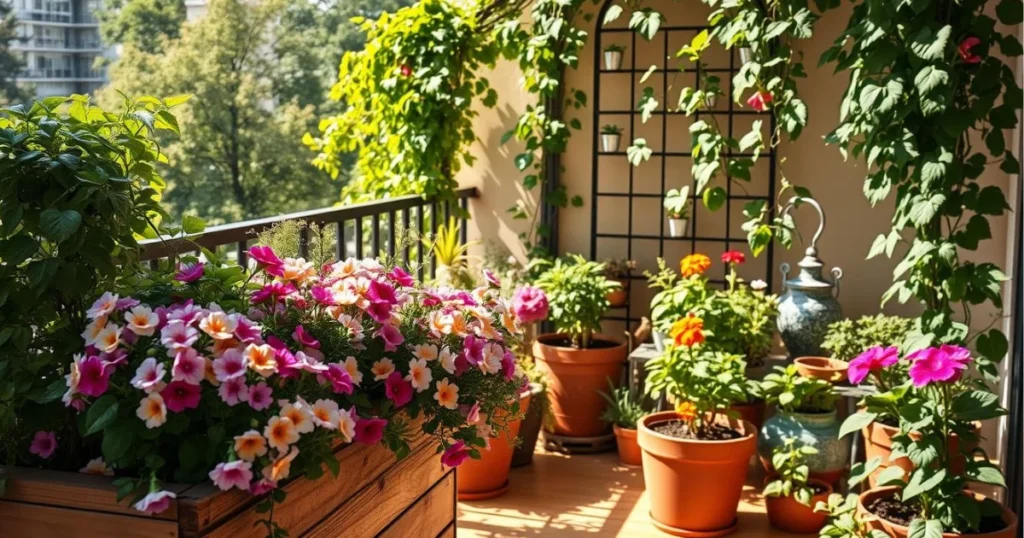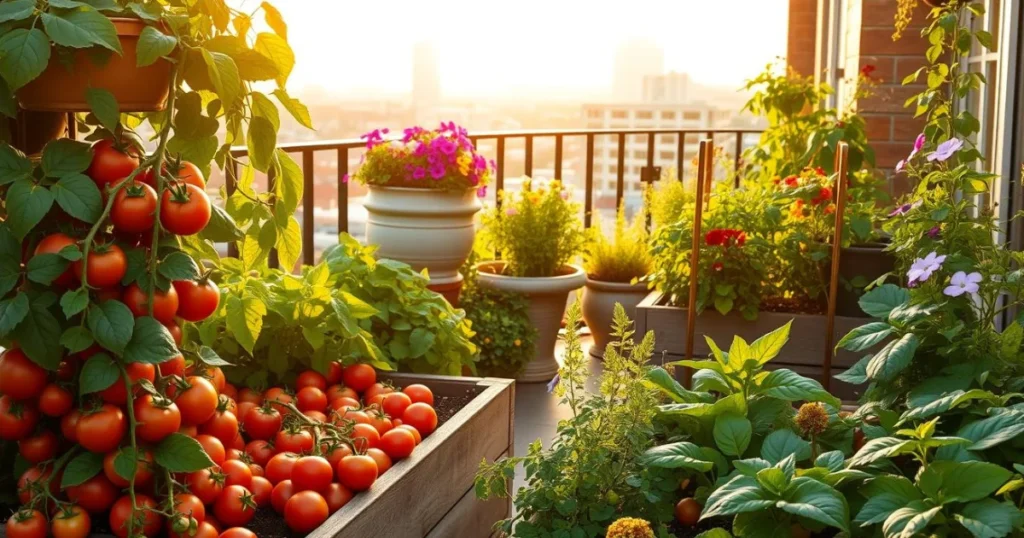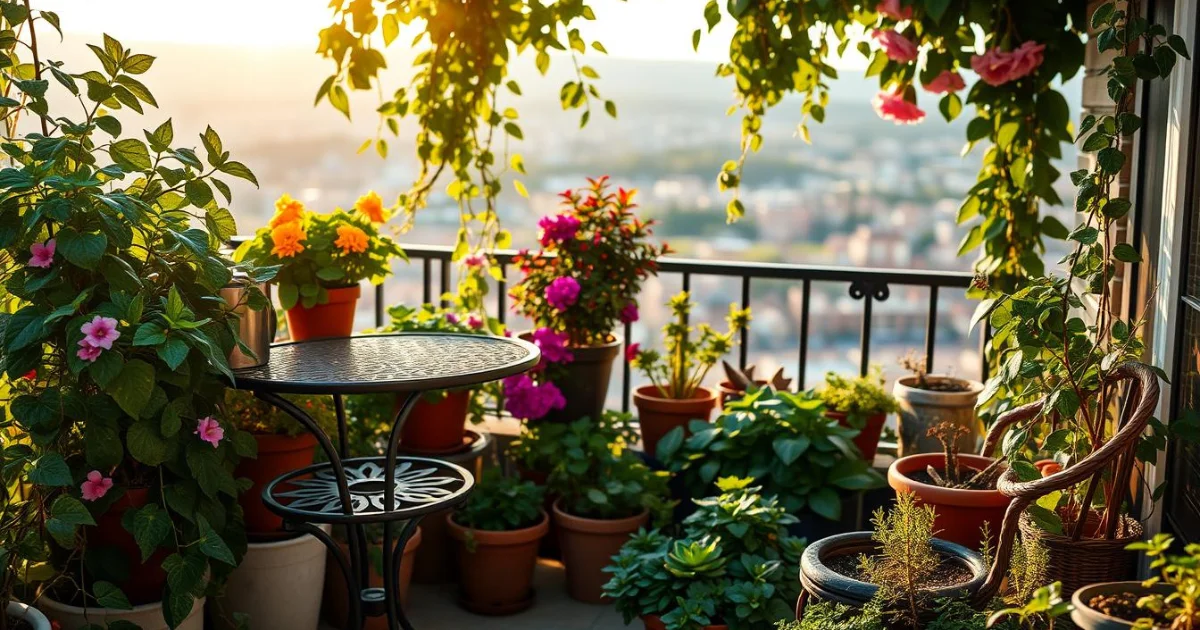Transform Your Balcony into a Thriving Garden
Gardening for Balcony Bliss lets you imagine stepping out onto your balcony and finding yourself surrounded by lush greenery and vibrant flowers. The soothing sounds of nature fill the air. Gardening on your balcony can be incredibly rewarding, creating a peaceful oasis in the city.
With the right design and container gardening, your balcony can become a thriving garden. It offers a serene escape from daily life’s stresses
By following balcony gardening principles and choosing the right plants, you can enjoy many benefits. These include better air quality, increased property value, and a sense of accomplishment. Whether you’re new to gardening or have experience, turning your balcony into a garden is possible with the right guidance.
Getting Started
To start your balcony gardening journey, understanding the challenges and opportunities of small spaces is key. Knowing the basics of balcony garden design and container gardening will help you create a beautiful outdoor area. It will not only meet your needs but also surpass your expectations.
Table of Contents
Getting Started with Balcony Gardening
Starting a urban balcony garden needs a good base. First, check how much space you have. Then, see how much sunlight your balcony gets. Also, think about wind that might harm your plants. This way, you can make a small balcony garden that looks great and works well.
Next, measure your balcony’s size and shape. Look at any obstacles or challenges. This helps pick the best balcony gardening ideas for your space. Also, check local rules to make sure your garden is safe and follows the law.
Important things to think about when planning your urban balcony garden include:
- Sun exposure: How much direct sunlight does your balcony receive, and how will this impact plant growth?
- Wind patterns: Are there any strong winds or gusts that could damage plants or disrupt your garden?
- Weight limitations: What is the maximum weight capacity of your balcony, and how will this impact your choice of containers and plants?
By thinking about these points and doing your homework, you can make a small balcony garden that’s full of life and beauty. Whether you’re looking for balcony gardening ideas or just want to improve your garden, start with a strong foundation and build up.
Creating Your Foundation: Soil, Pots, and Plant Choices
Starting your balcony garden begins with understanding the core components. For any aspiring urban gardener, selecting the right container is crucial. Options range from simple plastic containers and traditional pots of plants to advanced solutions like self-watering pots. Brands such as the Keter Easy Grow, Self Watering Planter Box and the Lechuza Cascada can simplify maintenance. The foundation for healthy plants is the right potting mix. Avoid using garden soil, which compacts easily and can introduce soil-borne diseases. Instead, opt for a high-quality potting soil or create your own soil mix. Products like Kellogg Patio Plus or a blend of organic potting soil and coco coir provide excellent drainage and aeration. For specific needs, a Seed Starting Mix is ideal for new seedlings. Consider adding amendments like Garden Lime to adjust pH. Understanding your specific environment, including your USDA Hardiness Zones and local sunlight patterns, will guide your urban plant choices and ensure better plant survival.
Essential Tools and Materials for Balcony Garden Success
To make a balcony vegetable garden or balcony herb garden thrive, you need the right tools and materials. This includes planters, soil, fertilizers, and irrigation systems. A good potting mix is key for healthy plants, and a watering can helps with watering. Gardening gloves protect your hands while working with plants.
When picking containers for your balcony vegetable garden, think about drainage, aeration, and root growth. Here are some important points:
- Select containers that have proper drainage holes to avoid waterlogged soil
- Select containers that provide adequate aeration for healthy root growth
- Consider the size of the container and the mature size of the plant
A balcony herb garden also needs the right containers. Look for ones that allow for good air circulation and moisture control. With the right tools and materials, you can have a productive balcony garden. It will bring fresh produce and beauty to your outdoor space.
Choosing the Right Containers for Your Balcony Garden
When you’re into container gardening for small spaces, picking the right containers is key. They impact your garden’s look and your plants’ health. With many choices, finding the perfect containers for your best plants for balcony gardening can be tough.
Start by thinking about the size and material of your containers. Big containers give roots more room but are heavy and hard to move. Smaller ones are easier to handle and can be moved around as needed.
Key Considerations for Container Selection
- Container size: Choose containers that are at least 5-7 gallons to provide enough room for roots to grow.
- Material: Select containers made from durable, weather-resistant materials such as plastic, wood, or metal.
- Drainage: Ensure your containers have proper drainage holes to prevent waterlogged soil.
By keeping these points in mind and picking the right containers, you can make a beautiful and thriving balcony garden. Don’t forget to use space-saving options like vertical planters, hanging baskets, and tiered containers. They help you make the most of your space and create a beautiful display.
Maximizing Space with Vertical and Strategic Planting
For anyone with an urban apartment, the mantra is to MAXIMIZE YOUR SPACE. This is where balcony gardening gets creative. A vertical garden is an excellent solution, transforming a bare wall into a lush vertical habitat. You can achieve this using tiered planters or plant hangers. This approach is perfect for growing a small vegetable garden with crops like snap peas and cherry tomatoes. The “Thriller, Spiller, Filler” is a classic design concept for container gardening that creates visually appealing arrangements. The “Thriller” is a tall, striking plant, the “Filler” adds mass, and the “Spiller” cascades over the container’s edge. You can also install a wind screen using materials like reed fencing or even chicken wire covered in vines to protect plants from harsh wind exposure, a common challenge in urban settings. This structure can also support climbing plants, further enhancing your vertical space.
Best Practices for Gardening for Balcony Environments
Gardening on a balcony needs a well-thought-out plan. Your garden design must consider the balcony’s unique challenges like wind, sun, and temperature changes. Choosing the right soil, fertilizers, and pruning methods is key. For example, using top-notch potting mix and regular fertilizing boosts plant health.
It’s also important to water your plants right. Too much water can harm them. So, finding the perfect watering balance is crucial. Also, keeping pests away is vital. Pests like aphids, whiteflies, and spider mites can damage your plants. Organic pest control, like neem oil or insecticidal soap, is a good choice.

- Water your plants once the soil feels dry when you touch it
- Fertilize your plants regularly, using a balanced fertilizer
- Prune your plants to promote healthy growth and prevent disease
- Regularly check your plants for any signs of pests or disease and take prompt action when needed.
By applying these tips, you can transform your balcony into a beautiful garden that brings charm and freshness to your outdoor space.
Selecting Plants That Thrive in Balcony Gardens
Creating a urban balcony garden starts with the right plants. It’s key to pick plants that fit your balcony’s conditions. This includes temperature, humidity, and wind. This way, your garden will be diverse and vibrant, adding joy to your space.
First, think about your balcony’s sunlight. If it’s sunny, choose plants like succulents, herbs, or flowers. For a shaded balcony, go for plants like ferns, peace lilies, or begonias.
A good urban balcony garden has both annuals and perennials. This keeps your garden interesting all year. Mix plants with different textures and colors for depth and beauty. Some great choices include:
- Succulents and cacti for easy care
- Herbs like basil, mint, and rosemary for a fragrant garden
- Flowers like petunias, geraniums, and begonias for color
By picking the right plants and following some tips, you can make a beautiful urban balcony garden. It will bring you joy and peace all year.
Creating Your Own Balcony Vegetable Garden
To make a great balcony vegetable garden, pick the right veggies. Look for compact or dwarf varieties. They’re made for growing in small spaces. Think about how long they take to grow, if they resist diseases, and how much they’ll produce.
Getting the soil right is key for a balcony vegetable garden. Use a good potting mix and add organic fertilizers. This gives plants the nutrients they need to grow well.
Here are some tips for your balcony vegetable garden:
- Choose containers with good drainage to prevent waterlogged soil
- Provide adequate support for plants using trellises, cages, or other support systems
- Keep the soil consistently moist, but not waterlogged

Follow these tips and pick the right veggies. You can make a small balcony garden that’s full of life and gives you fresh food. With the right care, your balcony vegetable garden will do great, and you’ll have plenty to harvest.
Choosing the Right Plants for Your Urban Ecosystem
Selecting native plants is a smart strategy for any plant lover. These native species are adapted to your local climate, including challenges like Chicago winters, and are more resilient. A native plant container garden can support local pollinators and improve air and water quality. For example, those in the Midwest might select native Illinois prairie species like Joe-pye weed or perennial sunflowers. Many native perennials and even shrubs like ground-covering junipers do well in pots. If you’re interested in edibles, consider heirloom varieties of vegetables, such as unique heirloom tomatoes like the Black Cherry. These urban plant choices contribute to a more sustainable environment. Experts like Jeremie Fant from the Chicago Botanic Garden and Ben Futa, featured on PBS Wisconsin‘s Let’s Grow Stuff, often highlight the benefits of using native and xeric offerings for their low-water needs and resilience in urban landscapes.
Design Tips for a Beautiful Balcony Garden
Creating a stunning balcony garden involves several key factors. It’s important to make a space that looks good and is functional. Use a mix of plants, containers, and decorations to achieve this. Techniques like vertical gardening and smart plant placement can help.
First, think about the look you want for your balcony garden. Do you like modern and sleek, or rustic and natural? This will help you choose the right containers, plants, and decorations. For example, terracotta pots can bring warmth and coziness.
- Using a mix of plant sizes and textures to add depth and visual interest
- Incorporating a variety of colors and blooms to create a vibrant and dynamic atmosphere
- Adding decorative elements, such as garden statues or string lights, to enhance the ambiance
By following these tips and thinking about your style, you can make a beautiful balcony garden. It can be a peaceful spot or a lively place for entertaining. A well-designed balcony garden adds value to your home.
Maintenance and Care Throughout the Seasons
Your balcony garden needs care as the seasons change. Regular upkeep is key for gardening for balcony success. This includes watering, fertilizing, and pruning to keep your garden healthy.
Think about your plants’ needs and your local climate when choosing balcony gardening ideas.
Having a good watering system is vital for your balcony garden. You might use a drip irrigation system or self-watering containers. Regular fertilizing with a balanced fertilizer helps your plants grow well.
- Spring: Plant new flowers and vegetables, and prune back any dead or damaged growth.
- Summer: Water regularly, and provide shade for plants that are sensitive to heat.
- Autumn: Harvest any ripe fruits and vegetables, and prepare your garden for the winter months.
- Winter: Protect your plants from frost and extreme cold, and consider bringing sensitive plants indoors.
By following these tips and staying on top of maintenance, you can enjoy a thriving balcony garden all year round. This way, you’ll make the most of your gardening for balcony experience.
Maximizing Your Balcony Garden’s Potential
To get the most out of your balcony garden, it’s key to pick the best plants for balcony gardening. Think about starting a balcony herb garden for fresh herbs all year. Remember to consider your balcony’s sunlight and the soil type.
For a great balcony garden, watch how your plants grow. Change their care as needed. Add new plants and features to keep it lively. Your balcony garden can also be a source of fresh herbs and veggies. Gardening brings many benefits, like stress relief, exercise, and meeting new people.
Here are some ways to enhance your balcony garden:
- Use different containers for a layered look and interest
- Put up a trellis or support for plants to grow up
- Try a self-watering system for easier, more efficient care
By following these tips and picking the right plants, you can make a vibrant and lovely space. It will give you fresh food and a connection to nature.
Advanced Techniques and Sustainable Practices
Elevate your balcony gardening with advanced gardening techniques and a focus on sustainability. An efficient drip irrigation system with Water emitters, or even a simple watering wand attached to a garden hose, ensures plants get consistent moisture without waste. For an even more eco-friendly approach, consider rainwater harvesting. Using an Organic fertilizer like Miracle-Gro All Purpose Plant Food can nourish your plants without harsh chemicals. It’s also important to be mindful of building regulations and building safety codes, especially concerning weight limits and Main plumbing or Secondary plumbing access. To protect your plants from early or late frosts, learn about frost protection methods, as frozen soil can be fatal. Finally, enhance the ambiance with solar-powered garden lights and contribute to a healthier ecosystem by avoiding standing water that can attract mosquito larvae. These efforts can transform a simple balcony into a productive and beautiful eco-friendly space, boosting food security and fostering a connection to nature.
Conclusion: Your Journey to a Thriving Balcony Garden
Starting your balcony garden journey? Remember, success comes from patience, persistence, and trying new things. Your garden will grow and change over time. Enjoy the journey and don’t hesitate to try new plants and techniques.
Use the tips and resources from this guide to spark your creativity. Join local gardening groups online and in your area. This way, you can share ideas, learn from others, and get inspired for your garden.
So, get ready to dig in and start your exciting gardening adventure. With the right care, your balcony can become a peaceful oasis. It will be a place of relaxation, nourishment, and connection to nature. Happy gardening!

